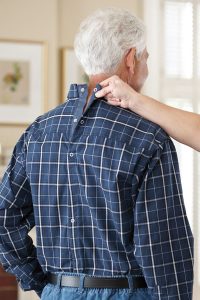Think about attempting to button a blouse when your fingers aren’t cooperating. Isn’t it annoying? Adaptive clothing helps to make life a little bit easier by fusing style and functionality. These clothing items are vital to the freedom of people with disabilities; they are more than just pieces of clothing. They are thoughtfully designed to accommodate all age groups, including children with special needs and the elderly. Read more now on senior clothing
Let’s go back in time now. For a very long time, people have viewed fashion as an identification sign. However, traditional attire frequently falls short in accommodating individuals who do not conform to the norm. Tight fittings, buttons, and zippers? For many, they can be adversaries. Introducing adaptive clothing with cleverly designed seams, elastic materials, and magnetic fasteners. These minor adjustments are subtle cues that everyone has the right to wear respectable clothing.

Have you ever watched a child put on their favorite pajamas and smile from ear to ear? The goal of adaptive fashion is to have everyone feel the same happiness. Imagine Velcro shoes and elastic waistbands—not because they’re “different,” but simply because they’re practical. They provide independence, so getting dressed isn’t a chore but a breeze.
Let’s also talk about fashion. Oh, for the days when being realistic meant being dull and uninteresting. Adaptive apparel is now on par with mainstream styles. Why should a person with mobility issues not dress stylishly in a blazer or pair of jeans? With these clothes, “I want to look good and feel good, too.”
Voices from the community are becoming louder. Advocates, parents, and caregivers unite to demand more choices. Well-known corporations are starting to take notice of their requests. No longer a niche, inclusive fashion is becoming a hot trend. And for good reason—who says there should be restrictions on fashion?
Think about the tale of one man: Jack, a lively soul imprisoned in a body that is immobile. And his clothes? An assortment of creative outfits that reduced the challenge of getting ready. Jack felt less reliant and more like himself with the seamless t-shirts and easy-off shoes. An implicit promise was represented in his attire: fashion for everybody, without exception.
Now for an interesting idea: what if every article of clothing had some degree of adaptability? The convenience is worth considering! Comfort and style might coexist in our planet. It’s time for fashion to welcome everyone.
Remember Jack and the innumerable others for whom this small gesture represents a victory the next time you put on your favorite attire. Keep in mind that fashion is more than simply cloth; it’s also about inclusivity, freedom, and innovation. Let’s advocate for a revolution in clothing that celebrates all individuals and bodies.
That’s adaptable fashion for you, making progress with every creative stitch. Let’s continue to applaud those who have the courage to reconsider the fundamental structure of fashion.